A Social Network Analysis of the Guerreros Unidos Crime Syndicate
Pilar Glaser, John P. Sullivan, and Nathan P. Jones
The United States and Mexico have maintained a strong partnership due to proximity and the mutual economic benefits of trade.[1] However, this proximity also creates vulnerabilities for criminal exploitation. Mexico has seen a continuous battle against transnational criminal organizations (TCOs) that has resulted in government corruption and a growing danger to US national security.[2] The shared border and existing trade agreements make the United States a target for criminal activity such as smuggling and violence.[3] This has been the case since the 1980s when the US-Mexico border became the favored route for smuggling drugs into the United States.[4] Since then, Mexican TCOs have increased drug production over the years and were identified as the greatest drug-supplying threat to the United States in 2021.[5]
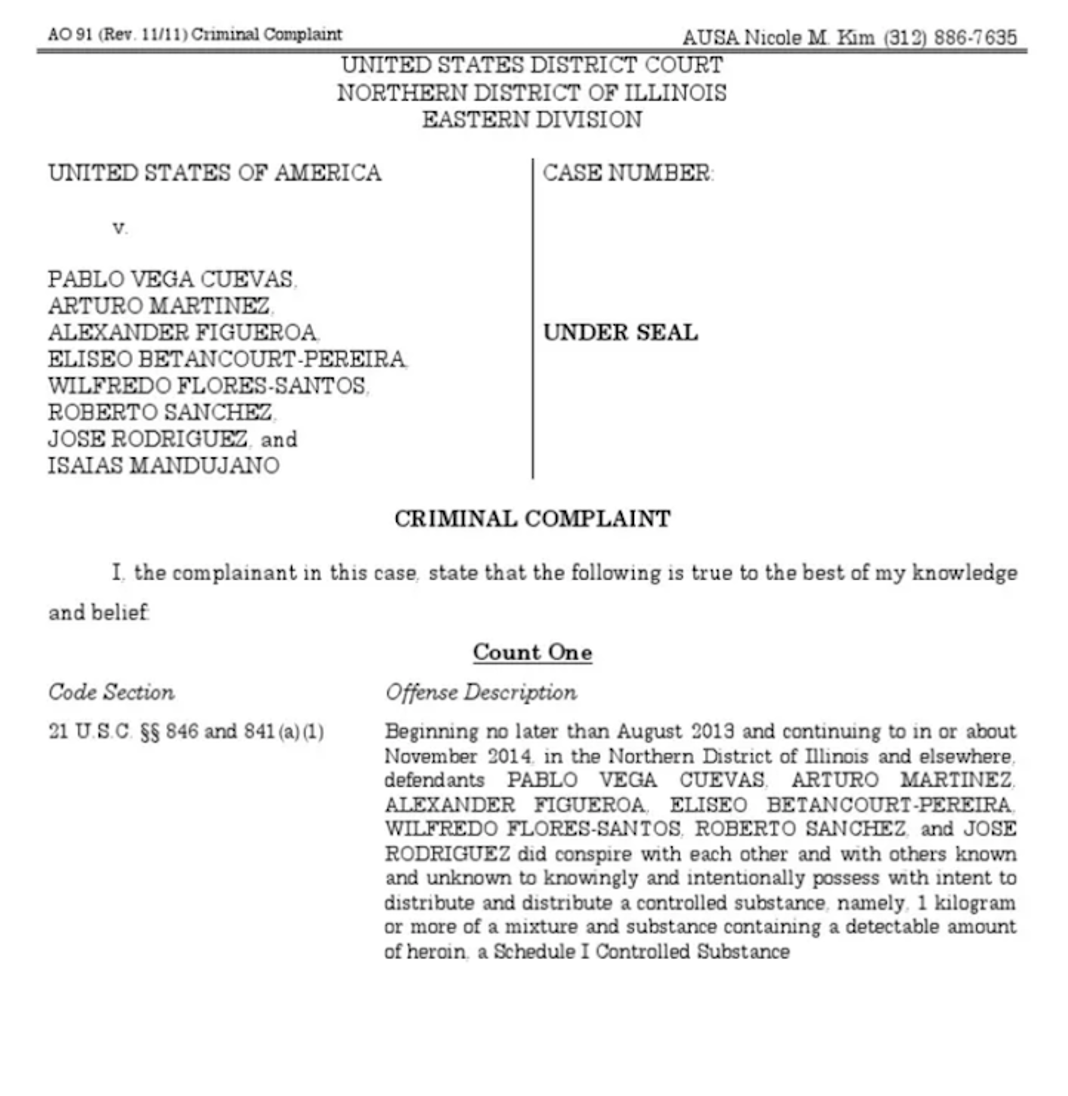
Face Page, Guerrero Unidos Criminal Complaint, United States v. Cuevas et al. (2014),
Northern District of Illinois.
The Guerreros Unidos: A Transnational Criminal Organization
Attempts to stop drug smuggling and intervene in Mexican crime syndicates have led to the decentralization and reorganization of smaller groups, such as the Guerreros Unidos organization,[6] which emerged out of a split of the Beltrán Leyva Organization (BLO) in 2010.[7] These fragmentations negatively impacted Mexico’s federal government, as smaller organizations are used for political assassination and bribery in addition to creating their own extortion markets and predatory crimes when profit starved.[8] The Guerreros Unidos crime syndicate has been implicated in drug smuggling, money laundering, bribing government officials, abduction, and murder since its formation.[9] After the splintering of the Beltrán Leyva Organization (BLO) and the formation of the Guerreros Unidos, violence only increased as the newly formed smaller cartels began fighting for power in the area of Guerrero, Mexico.[10]
Guerrero is a historically underserved area with a growing rate of violence that local law enforcement has had minimal success quelling.[11]The evolution of these smaller crime syndicates has made identification and disruption difficult. Further, these smaller, more violent groups have formed alliances with one another to increase resilience and gain access to resources in a bipolar and somewhat sparse network.[12] The continued expansion of operations has created a notable threat to United States security as the Guerreros Unidos crime syndicate moves illegal substances and proceeds through the United States. This expansion has reached as far north as Illinois, as identified by the indictment used for this study. While the indictment primarily focuses on plant-based drugs such as heroin, these same smuggling networks could today be used for fentanyl, which has led to more than 70,000 overdose deaths in the United States.
Social network analysis (SNA) is a collection of methods and theories for examining how the relationships between members of an organization can impact their activities and decisions.[13] The dynamic nature of criminal organizations and the difficulty of quantifying relationships within them makes SNA a powerful tool for analyzing these organizations. It has become a way to standardize the study of internal structures of organizations or between organizations.[14] It helps map organizational structures that balance secrecy and performance.[15] While this could apply to any organization with security concerns, SNA has proven beneficial in helping law enforcement understand the increasingly complex global criminal organizations.[16]
This article will explore the internal structures of the Guerreros Unidos organization. To achieve this, we provide a historical case study of the organization to establish context for the SNA. Court documents from the United States v. Cuevas et al. (2014) indictment focusing on the extensive wiretaps in the case will be used to conduct SNA.[17] This work will provide an exploratory analysis of a sector of the Guerreros Unidos organization and should be understood in that context.
Literature Review
Globalization has increased the opportunity for crime as the connections between nations grow, and smaller, flexible networks can take advantage of these relationships.[18] This has led to an estimated revenue of $1.6 trillion to $2.2 trillion for transnational crime globally in 2017.[19] These crimes negatively impact the economies and national security of many countries, creating a transnational issue. Within this trillion-dollar illegal economy, the drug trafficking industry makes up about one-third of this profit and continues to grow as the equipment is affordable and risk remains low.[20] It is common to see organizations involved in drug trafficking also involved in other illegal activities and violent crimes that can spill across borders.[21]
Mexican TCOs are the most prominent drug trafficking threat to the United States.[22] Violence and drug trafficking in Mexico have increased since 2006 when Mexico’s war on drugs began.[23] Mexico’s northern border has become a distribution route and epicenter of violence due to its proximity to the United States and the market the United States represents.[24] In 2017 alone, Americans purchased $153 billion worth of illegal substances.[25] This opportunity for profit has made drug trafficking to the United States a violent industry as groups battle for territory and transportation routes in Mexico. Control of these territories has made organizations, such as the Sinaloa Cartel and the Cártel Jalisco Nueva Generación (Jalisco New Generation Cartel or CJNG), the largest TCOs in Mexico.[26] However, these organized groups constantly evolve as new rivalries form and government intervention continues.[27]
This has included the splintering of larger organizations and the Mexican government’s arrest of 25 of 37 top illicit network leaders during the Calderon Administration (2006–2012), both leading to smaller, more violent organizations.[28] These smaller networks have proven resilient partly due to their ability to form alliances, as Jones et al. 2022 have shown.[29] The United States participates in joint operations with Mexico to help ensure stability in the country and minimize the role Mexico plays in the US drug problem.[30] With overdoses in the United States on the rise and drugs from other countries (such as Colombia and China) also moving through Mexico to get to the United States, it has become a national security priority to combat this.[31]
The Guerreros Unidos (GU) organization is one of these splinter organizations, originating from former members of the BLO and staking claim to Guerrero, Mexico.[32] The organization first garnered attention in 2011 after claiming responsibility for the murder of three people in Morelos, Mexico, which they quickly followed with several other attacks.[33] The state of Guerrero has become a major producer of illegal substances, such as heroin and poppy, and is known to be one of the most violent areas in the country.[34] GU’s smaller network size and existing rivalries have made allies necessary for moving drugs to the United States. Conflict with the Los Rojos, La Familia Michoacana (LFM), and the Caballeros Templarios (CT) have made the relationship between the GU and the Cártel de Jalisco Nueva Generación (CJNG) necessary for survival.[35]
The CJNG split from the Sinaloa Federation and is responsible for more than a third of the United States’ illegal drug market.[36] This partnership allows the Guerreros Unidos to utilize the passages, resources, and transportation of the CJNG to move drugs into the United States. While participating in drug trafficking, the organization also has committed crimes related to human trafficking, government corruption, abduction, and murder.[37] The expansion of violence outside of organization turf wars to include government officials, judges, law enforcement, and innocent civilians has led to destabilization in the region.[38]
The Guerreros Unidos organization is infamously connected to the 2014 kidnapping and murder of 43 college students traveling from Iguala to Mexico City.[39] Known as the Ayotzinapa or Iguala Massacre, students on their way to a protest for teacher wage reform disappeared.[40] It has come to light that the Mexican state and Guerreros Unidos conspired to abduct, torture, and kill the students.[41] When two GU members, Jonathan Osorio and Patricio Reyes Landa, were detained by Mexican law enforcement, they confessed to their involvement and the involvement of the Iguala and Cocula police.[42] Following arrests made in the case, the Mexican government put out a statement identifying the roles of the Iguala police in arresting the students to hand over to the GU for execution.[43] The investigation has exposed government shortcomings and seen the death of 26 key witnesses.[44]
By 2018, the involvement of law enforcement and government officials led to dozens of arrests.[45] As of 2023, Mexico has issued arrest warrants for 83 people, including 20 members of the Mexican military, in connection to the 43 missing students.[46] The continued investigation into this case has also exposed over 60 mass graves.[47] These mass graves were found across Guerrero, including on Guerreros Unidos' inhabited property.[48] To date, only the remains of three students have been found.[49] This has led to investigation and speculation surrounding the level of corruption in Mexico’s government by the GU. The growing examples of GU leaders allegedly infiltrating Mexico’s political class, military, and law enforcement agencies, the discrepancies in the case of the forty-three missing students, and the government’s attempt to blame municipal police has led to public mistrust.[50] Reporters, such as Anabel Hernandez, have worked to identify the high-level officials responsible for this coverup.[51]
Government corruption has included abdication of the duty to intervene against organized crime and government officials assisting organized crime in exchange for money or services. The absence of government law enforcement has left areas heavily impacted by violence underdeveloped and marginalized socio-economically.[52] This has allowed violence to increase as murder rates reached an all-time high in 2019, and these TCOs, criminal armed groups (CAGs)[53], and local organized crime groups (OCGs) or gangs were able to take over legitimate businesses that fuel local economies.[54] The GU, like other OCGs in Mexico and Latin America, is also involved in the extortion of businesses and public officials.[55] This includes owning real estate and businesses such as daycare centers, gas stations, production factories, and more.[56] In 2018, 20 state governors were arrested or investigated for their involvement with these criminal organizations.[57] The Mexican public confidence in their government has been severely diminished due to the continued involvement and subsequent arrest of government officials for corruption.[58] The Guerreros Unidos is one of many organizations that makes regular bribery payments to government officials, law enforcement, and the Mexican military.[59] This corruption perpetrated by the GU has continued following the events of 2014.[60] The overwhelming amount of corruption in government and law enforcement makes it difficult to combat these transnational crime organizations.
As Guerrero has become more violent and has been the location of two of the deadliest crime war events in Mexico, the Ayotzinapa Massacre of 2014 and the confrontation between CJNG members and law enforcement in Michoacan (2015), there has been more government attention on the Guerrero area.[61]
This government crackdown has included the arrests of Guerrero Unidos leaders Mario Casarrubias Salgado, Cleotilde Toribio Renteria, and Sidronio Casarrubias Salgado.[62] The Mexican Army has also reported conducting an operation that killed 22 alleged Guerreros Unidos members.[63] The 2014 case of the United States v. Cuevas et al. (2014) was part of a DEA joint operation with Mexican law enforcement to dismantle the Guerreros Unidos operating in Illinois.[64] The events of the 2014 massacre have since led to a chain of arrests of GU leadership and a weakening of the organization.[65] This disruption by law enforcement has continued an ongoing struggle with violence in the region, including human rights violations by the Mexican government.
Understanding the structure of these illicit networks is important to understand how they change over time and how to disrupt them.[66] Changes in this field are already being observed as organizations involved in drug trafficking have shifted from a hierarchical, family-based structure to a decentralized network made up of multiple leaders.[67] In 2015, Mexican officials believed the Guerreros Unidos operated in a hierarchical structure that dissolved into a more decentralized network.[68] This means it is easier for the organization to adapt as there are established actors to continue operations within the network in the event of a disruption.[69] However, it is unknown if this is an accurate description or if the disrupted sections of the larger network are representative of the network as a whole, and more research is needed. This project seeks to fill that gap in the literature.
Methods: Data Source and Collection
The raw data for this analysis was collected from the 2014 United States v. Cuevas et al. (2014) indictment, consisting of wiretaps and surveillance, as part of a counternarcotics investigation.[70] These court documents include the communications of high-ranking members of the Guerreros Unidos crime syndicate, particularly in Illinois, and evidence of their illegal activities dating back to 2013. The Drug Enforcement Administration (DEA) acted as the lead investigative agency in this case. The targets of the investigation were determined by surveilling associates of known Guerreros Unidos members and information provided by confidential informants. It should be noted that indictments are allegations, and all indicted individuals are considered innocent until proven guilty in a court of law.
When collecting the data for the SNA, the list of actors was first established by coding each party mentioned by name or identifying codename as a node. This provided a list of known parties observed by law enforcement and opportunities for communication surveillance. Actors that had no recorded communications were eliminated from the relationship visualizations. Ties or edges between these nodes were coded based on the form of communication to represent the relationship between members of the Guerreros Unidos and their associates. The forms of communication were categorized as text messages, phone calls, or face-to-face meetings based on surveillance performed by law enforcement.
For further pattern analysis, the subject of the communication and available attributes of each actor were also noted. This included details such as roles within the organization and familial ties. This data analysis only includes instances where law enforcement monitored the communication, but not the mention of previous meetings by actors (hearsay). The authors made this distinction to maintain the accuracy and reliability of the communication data; thus, we chose to exclude hearsay edges to increase the validity of the data. SNA has limitations, such as the validity of the underlying data and the gaps in information collected. This data was collected via coding an indictment of the GU. Indictments are a form of arrest warrant data which, as Berlusconi (2013) points out, is a form of a purposive sample that is likely to include all of the key players that would be included within a full wiretap data set, though some ties may be missing.[71]
Data Formation
Gephi and UCINET, social network analysis and visualization tools, were the predominate tools used to prepare and analyze the data.[72][73] For information about how the relationships between actors were coded, see Appendix A. Following the importing of the actor list, the edge list was created by identifying relevant communications between actors previously listed (See Appendix A Table A2).
This information was further broken down to differentiate the count data by communication type. This was used to analyze preferred communication forms for actors within the network and identify changes to the network based on preferred communication type. Actor centrality and subgroups within the network were also identified. SNA will help identify how the frequency of communication impacts decision-making in the organization and quantify behaviors so that future predictions can be made.
Results
Before delving into the SNA results of the 2014 GU analysis, a discussion of current and continued levels of GU violence is needed. Between 2018 and 2022, violence involving Guerreros Unidos continued to spread outside of Guerrero, Mexico. Based on data collected by the Armed Conflict Location and Event Data Project (ACLED) during this five-year period, there are a growing number of dangerous conflicts linked to the organization.[74] ACLED worked to collect all real-time reports of political violence based on location and involved parties. There are limitations to this data based on the availability of information reported and the identification of GU members in these reports. The map (Fig. 1) shows various areas where GU members engaged in dangerous conflicts and the details of the events.
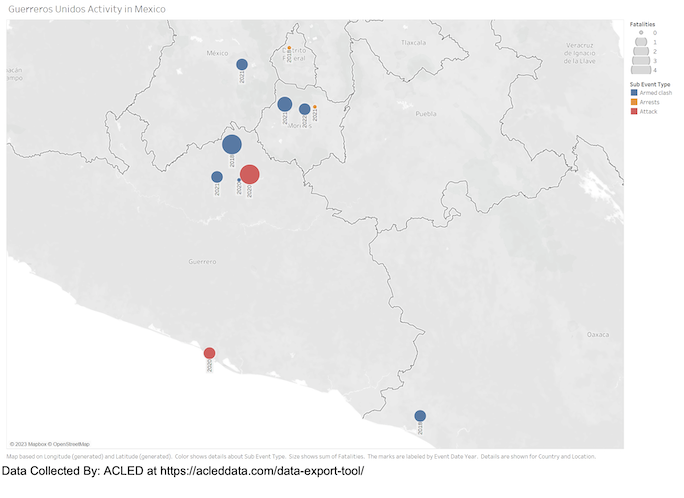
Data Collected By: ACLED at https://acleddata.com/data-export-tool/
Figure 1. Violence Involving the Guerreros Unidos Between 2018 and 2021 in Mexico
The patterns of violence in Mexico involving Guerreros Unidos span several states (Fig. 1). The dates of each incident indicate a steady trend of violence involving both civilians and authorities. The fatality rate associated with attacks on civilians has been comparable to events against other transnational criminal organizations or law enforcement. The continued presence in Guerrero and the surrounding area shows the ongoing threat posed by the organization since the 2014 United States v. Cuevas et al. (2014) indictment.[75]
The results from the SNA showed that the portion of the Guerreros Unidos network (N = 19), identified in the 2014 United States v. Cuevas et al. (2014) indictment, is locally dense.[76] The overarching network has a degree centralization score of 0.510.
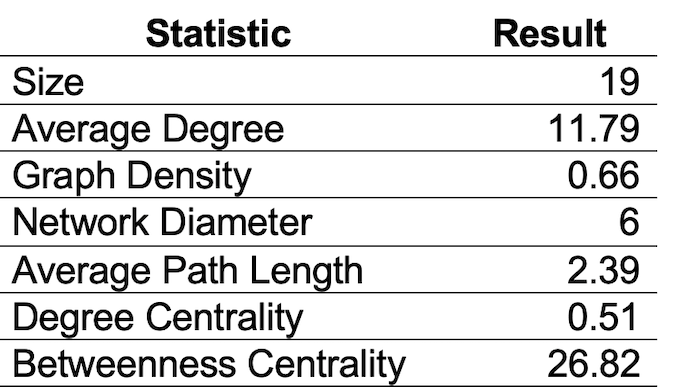
Table 1. Key Network Topography Measures
Based on the information collected from law enforcement surveillance, the network has 19 actors (Table 1). This result is based on the number of actors that law enforcement was able to observe communicating with other members of the Guerreros Unidos. The short path length can be reflective of how quickly the network is able to disseminate information. As a small network, this is not unusual; however, the graph density reflects the interconnectedness of the network. Calculated based on the size of the network and the number of ties between actors, this statistic points to a highly connected network topography. Previous research has identified networks of similar density as this GU network, 0.66, to be dense.[77][78] Data collected was also able to provide some relationship ties between actors outside of communication, such as familial ties. Based on this information, it is possible this could have led to an increasingly dense dark network.[i][79] These ties included actors in the network having siblings and spousal ties to Vega.
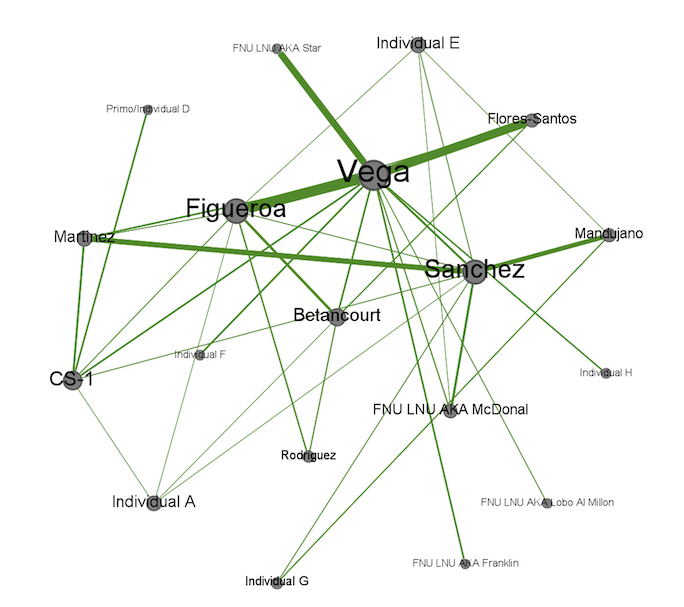
Figure 2. Communication Frequency Between Actors with Nodes Sized Based on Degree Centrality
Actors Vega, Figueroa, and Sanchez had the highest frequency of communication with other members of the network, as seen by the increased thickness of their relationship ties (Fig. 2). This high rate of communication has made these actors more central to the network. Identifying these actors can quantify their importance to network operations and their power over other actors within the organization.
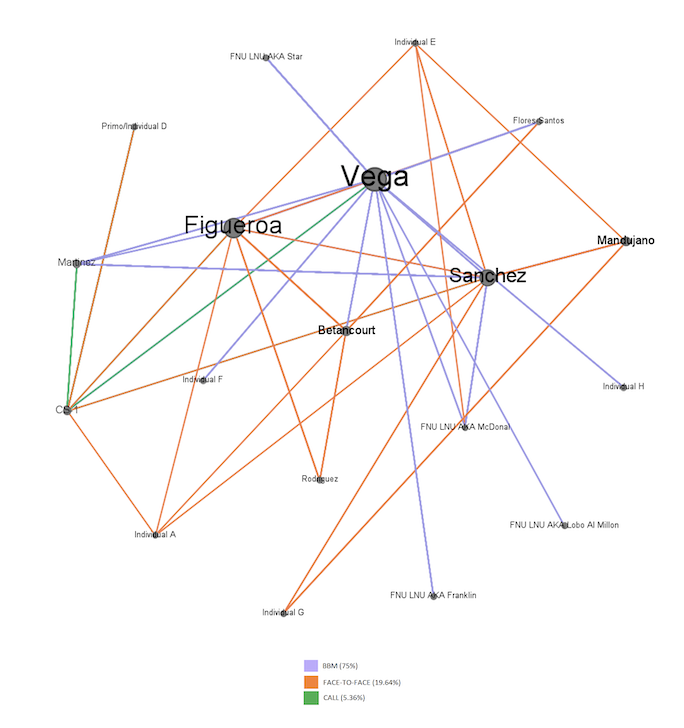
Figure 3. Preferred Communication Type Between Actors with Nodes Sized Based on Betweenness Centrality
The communication types used by members of the network show a preference for text messaging, referred to as BBM in the dataset, as this mode of contact accounts for 75% of all recorded communication (Fig. 3). In comparison, face-to-face meetings were recorded 19.64% of the time and 5.36% of communications were telephone calls. These different forms of communication are impacted by the location of actors, their roles in the organization, and how they choose to disseminate information to prioritize security and efficiency. This may have been in part due to the perception that encrypted Blackberry messages were more secure. The following three figures (Fig, 4A, 4b, and 4C) describe the “Networks for Each Communication Type.”
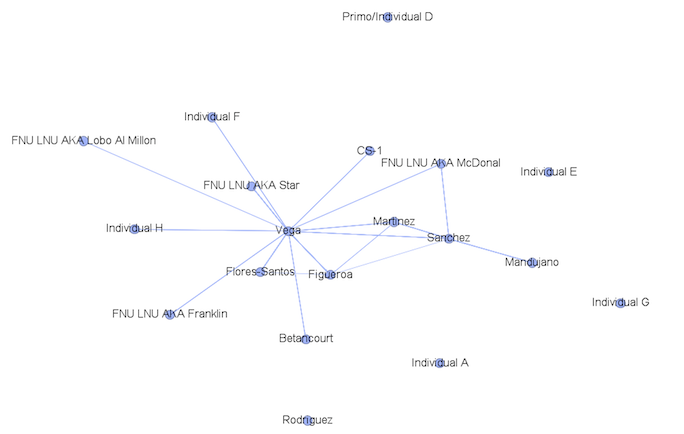
Figure 4A: Text Message Communication Network (Above)
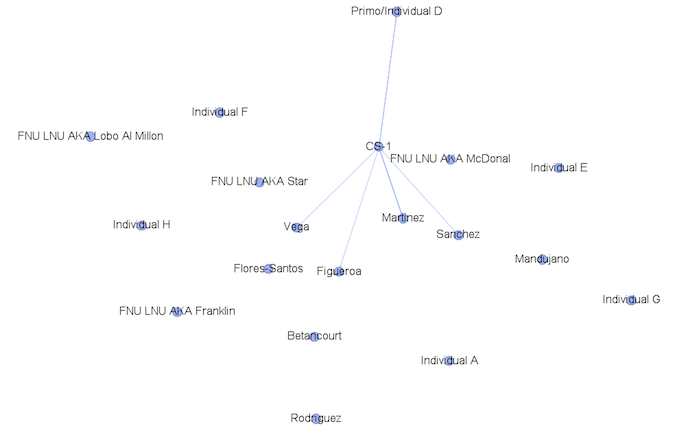
Figure 4B: Face to Face Communication Network (Above)
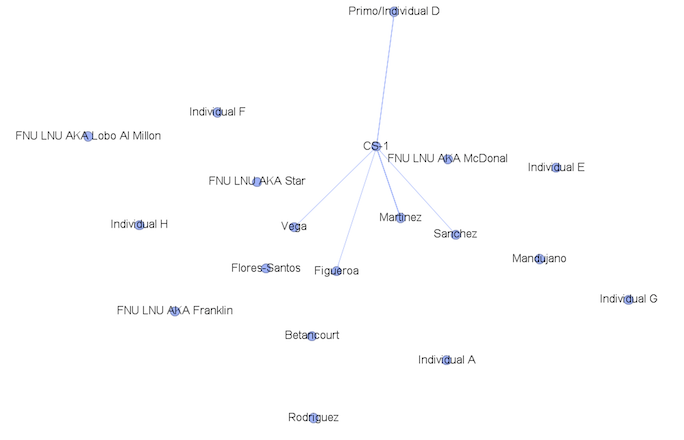
Figure 4C: Phone Call Communication Network (Above)
There are actors who did not use all three modes of communication (Fig. 4). Notably, the three actors with the most communication are present in all three communication type networks. The face-to-face network also works to provide some location data (Fig. 4B). The confidential informant, CS-1, is also present in all three networks. Previous research has pointed to the centrality of confidential informants in dark networks under law enforcement surveillance.[80]
Vega, Figueroa, and Sanchez have the highest number of ties within the network. In other words, these actors communicate more frequently with other actors. This aligns with the analysis provided in Figure 2. The confidential informant, CS-1, has a lower-than-average number of ties based on the entire network. This metric helps identify the importance of an actor in the network.
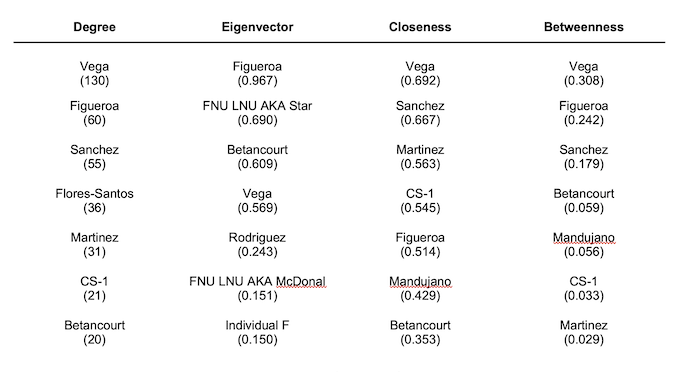
Table 2. Actor Centrality Scores
The eigenvector centrality highlights actors who have close ties to other central actors, such as Figueroa, FNU LNU AKA Star, and Betancourt. The closeness centrality highlights that FNU LNU AKA McDonal, Vega, and Sanchez are integral to the dissemination of information in the organization (Table 2). Vega, Sanchez, CS-1, and Figueroa are all close to the rest of the network as well. The betweenness centrality helps to identify actors that function as brokers between separate sections within the network. Vega, Sanchez, and Figueroa are identified as the most frequent actors to fall on the shortest paths of communication between other actors. This can also point to the level of authority these actors hold within the organization. The following two figures (5A and 5B) provide an “Analysis of Subgroups and Bridge Actors Within the Network Using the Girvan-Newman Algorithm.”
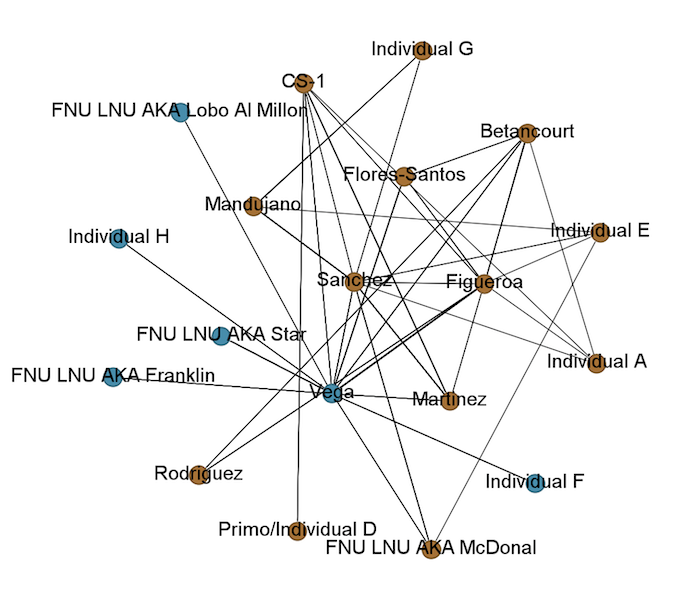
Figure 5A: Full Network Subgrouping Defined by the Girvan-Newman Algorithm (Above)
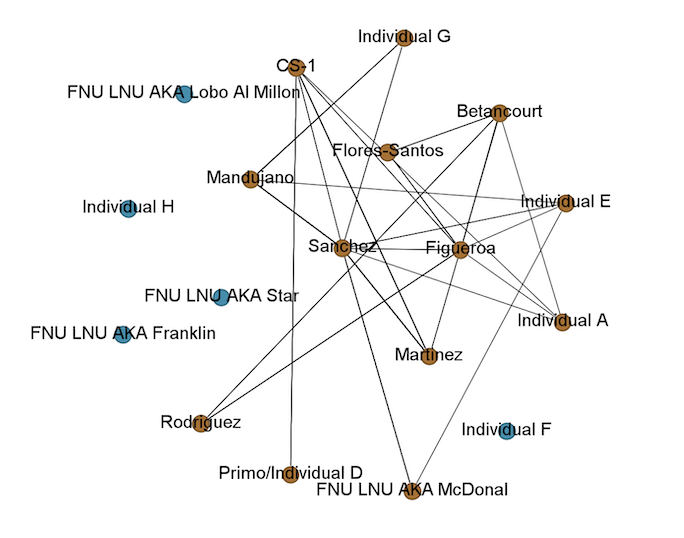
Figure 5B: Subgroups Defined by the Girvan-Newman Algorithm with the Highest Degree Actor Removed (Above)
The network consists of two subgroups, as detected by the Girvan-Newman algorithm, and is connected by a single actor that acts as a broker/cutpoint (Fig. 5A).[81] The Girvan-Newman algorithm identifies communities within a network to cluster more connected actors in a larger network.[82] The two subgroups are connected by a singular actor, Vega (Fig. 5A). The subgroup including Vega contains the actors that have roles such as wholesale narcotics suppliers and leaders of the Guerreros Unidos network (Fig. 5A). The other subgroup contains actors involved in the sale and distribution of narcotics in the United States (Fig. 5B). With Vega removed from the network the two networks no longer have any ties, and the subgroup including Vega loses all ties between actors. This shows the value of Vega as a bridge in the network.
Discussion
The pattern of violence in the past five years shows that not only are Guerreros Unidos organization activities continuing to move north but that there is a continued threat of violence. This shows that the threat this organization poses is not localized to Guerrero, Mexico, and that the organization is still active. Despite fragmentation and the loss of cells like this one, the GU is resilient. This may be due to its ability to form alliances with larger groups such as the CJNG, as recent research has shown.[83]
The violence and corruption associated with the GU warrants special attention due to its presence as far north as Illinois. Other studies have found that the United States is not immune to the risk of corruption, which allows for illicit activities and violence, particularly as it pertains to the drug trade.[84] It can be concluded that members of the Guerreros Unidos organization operating in the United States could increase the risk of violence/corruption. Further, given these heroin trafficking networks can easily smuggle fentanyl in lieu of heroin, the existence of the networks could result in continued high levels of overdose deaths from synthetic opioids, a rising public safety issue.
This section of the Guerreros Unidos network is highly interconnected. We know this based on the higher-than-average graph density and the high number of ties between actors. Research has found this to be common in covert networks as they prioritize trust and loyalty to the organization but compartmentalize operations.[85] While this offers some protection, it also makes it easier for law enforcement to map the entire network and disrupt it through the removal of a few key players. The interconnectedness of this network made it easier for law enforcement to identify members of the organization and gather evidence of illegal activities. The frequent communication between most members of the network and the vital roles each member played would make it difficult for this section of the network to adapt or recover from the arrests made in the 2014 United States v. Cuevas et al. (2014) case.
This communication frequency can also point to a hierarchy within the network or how integral an actor is to the organization’s function. Vega, Figueroa, and Sanchez had the highest recorded frequency of communication. In counternarcotic cases, the available information changes, and there is not always the time or resources to explore every avenue of investigation. This measure can help prioritize actors that warrant further investigation. Identifying key players is necessary to discern between actors that are critical for the dissemination of information or the communication between larger parts of the network.[86] In this case, it could be determined that Vega acted as the bridge to the larger network, and actors such as Figueroa and Sanchez were critical for the dissemination of orders to other actors in the network. With this type of information, law enforcement can understand how best to disrupt the network. The preferred method of communication between the network can help direct resources and identify the roles actors play. In this network, text message communication, or a texting application known as BBM, comprised a majority of recorded communications. The contents of these messages were integral to building a case against Vega and other members of the organization.
Vega, Sanchez, and Figueroa are identified as key players in the network based on the impact of their removal in fragmenting the network. The higher levels of degree centrality associated with Vega, Figueroa, and Sanchez confirm their importance to the network. These actors are more active in the network and are more likely to be sources of information. This metric can make them more valuable targets for law enforcement. In this instance, these actors were the biggest sources of evidence for the case. A confidential informant participated in this case, and research has shown the possibility of a biased network based on their testimony and law enforcement investigation bias.[87] However, in this network, the confidential informant was below the network average for degree centrality. This information can help verify the absence of investigative biases.
The eigenvector centrality draws attention to another important actor in the network referred to as “Star.” This measure can be representative of the indirect power an actor has in the network.[88] In this case, Star was identified as one of the narcotics suppliers to the organization. This measure can help identify actors that have integral roles in the organization outside of the power hierarchy. Actors such as Martinez and the confidential informant, CS-1, were more statistically significant in the closeness centrality measure than other measures. This could signify an increased level of importance to the network as these actors have more access to the rest of the network. Vega, Figueroa, and Sanchez had the highest betweenness centrality in the network. This correlates with previous observations that these actors are high-ranking in the organization and act as bridges for communication between the Illinois network and the larger Guerreros Unidos network.
This information can be compared to other illicit networks to identify trends in how these groups organize. Deductions made from these network statistics can benefit future law enforcement counternarcotics operations and encourage further research into the nature of law enforcement investigation practices. The expansion of network surveillance has the opportunity to improve law enforcement disruption. Further research is needed to understand the effectiveness of social network analysis for an ongoing investigation and if this research is reflective of the larger Guerreros Unidos network.
Appendix A
To prepare the data, the actors list was created within the predetermined network boundaries by the court case (Table A1). This included actors such as CS-1 who operated as a confidential informant for the investigation.
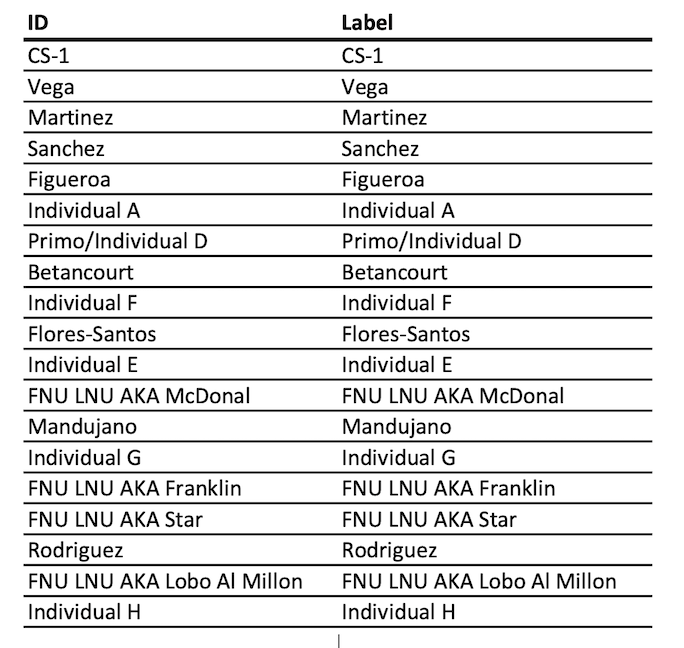
Table A1. Actors Identified in Guerreros Unidos Crime Syndicate
Each instance of communication was identified by the parties involved and the method of communication used (Table 2). Dates and details of the communication were also recorded to aid the organization and identification of potential patterns in the ties between actors; however, this information was not included in the initial data importing process. This included 224 recorded instances of communication between actors over the course of the investigation carried out by the DEA.
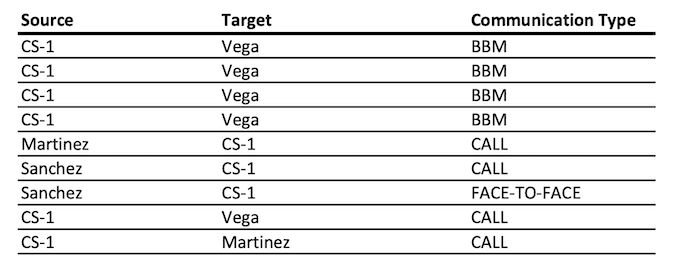
Table A2. A Section of the Communication List Between Actors (Edge List)
Endnotes
[1] US Department of State. Bureau of Western Hemisphere Affairs. U.S. Relations with Mexico. 13 September 2023, https://www.state.gov/u-s-relations-with-mexico/.
[2] June S. Beittel. “Mexico: Organized crime and drug trafficking organizations." (CRS Report No. R41576). 2022. Retrieved from the Federation of American Scientists website, https://sgp.fas.org/crs/row/R41576.pdf.
[3] Michael Alan Broadway, "Mexican Drug Cartels and Their Effects on Society." No. 388, Integrated Studies. Spring 2022, https://digitalcommons.murraystate.edu/bis437/388.
[4] Ibid.
[5] “2020 National Drug Threat Assessment.” Drug Enforcement Administration. 2021, https://www.dea.gov/documents/2021/03/02/2020-national-drug-threat-assessment.
[6] “Guerreros Unidos.” InSight Crime. 13 August 2021, https://insightcrime.org/mexico-organized-crime-news/guerreros-unidos-mexico/.
[7] Op. cit., Beittel at Note 2.
[8] Laura Ross Blume. "The old rules no longer apply: Explaining narco-assassinations of Mexican politicians." Journal of Politics in Latin America. Vol. 9, No. 1. 2017: pp. 59-90, https://doi.org/10.1177/1866802X1700900103.
[9] Op. cit., Beittel at Note 2.
[10] Chris Kyle, “Violence and Insecurity in Guerrero.” Woodrow Wilson International Center for Scholars, Mexico Institute. January 2015, https://www.wilsoncenter.org/publication/violence-and-insecurity-guerrero.
[11] Vanda Felbab-Brown, “The Rise of Militias in Mexico: Citizens' Security or Further Conflict Escalation?” Prism. Vol. 5, no. 4. 2016: pp. 172-187, https://www.jstor.org/stable/26459219.
[12] Nathan P. Jones, Irina A. Chindea, Daniel Weisz Argomedo, and John P. Sullivan. "A Social Network Analysis of Mexico’s Dark Network Alliance Structure." Journal of Strategic Security. Vol. 15, no. 4. 2022: pp. 76-105, https://www.jstor.org/stable/48707886.
[13] Sean F. Everton, Disrupting Dark Networks. Cambridge: Cambridge University Press, 2012.
[14] Gisela Bichler, Aili Malm, and Tristen Cooper. "Drug supply networks: a systematic review of the organizational structure of illicit drug trade." Crime Science. Vol. 6, no. 1. 2017: pp. 1-23, https://doi.org/10.1186/s40163-017-0063-3.
[15] Op. cit. Everton, at Note 13; Carlo Morselli, Cynthia Giguère, and Katia Petit. "The efficiency/security trade-off in criminal networks." Social Networks. Vol. 29, no. 1. 2007: pp. 143-153, https://doi.org/10.1016/j.socnet.2006.05.001.
[16] Giulia Berlusconi, “Social Network Analysis and Crime Prevention.” in Benoit LeClerc and Ernesto Savona, Eds., Crime Prevention in the 21st Century. New York: Springer. 2017.
[17] “United States v. Pablo Vega Cuevas, Arturo Martinez, Alexander Figueroa, Eliseo Betancourt-Pereira, Wilfredo Flores-Santos, Roberto Sanchez, Jose Rodriguez, and Isaias Mandujano.” United States District Court for the Northern District of Illinois. 10 December 2014, https://www.justice.gov/sites/default/files/usao-ndil/legacy/2015/06/11/pr1210_01a.pdf. See also, “Eight Defendants Charged With Distributing Heroin In Chicago Area On Behalf Of Guerrero Unidos Mexican Drug Cartel.” Press Release, United States Attorney's Office, Northern District of Illinois. 10 December 2014, https://www.justice.gov/usao-ndil/pr/eight-defendants-charged-distributing-heroin-chicago-area-behalf-guerrero-unidos. Indictments can serve as a “purposive sample” that is likely to identify key players of an illicit network. See Giulia Berlusconi, “Do All the Pieces Matter? Assessing the Reliability of Law Enforcement Data Sources for the Network Analysis of Wire Taps,” Global Crime. Vol. 14, no. 1. 2014: pp. 61–81, https://doi.org/10.1080/17440572.2012.746940.
[18] Mario J. Osorio Beristain. "Impact of globalization and use of violence within Italian and Mexican criminal groups." Sapienza Universitá di Roma. Working Paper no. 4. 2021, https://phd.uniroma1.it/dottorati/cartellaDocumentiWeb/54cab7b6-c57d-4536-ba48-d500148ad0d7.pdf.
[19] Channing May. "Transnational crime and the developing world." Global Financial Integrity. 2017: pp. 53-59, https://www.gfintegrity.org/wp-content/uploads/2017/03/Transnational_Crime-final.pdf.
[20] Ibid.
[21] Op. cit., Beittel at Note 2.
[22] Op. cit., DEA at Note 5.
[23] Op. cit., Osorio Beristain at Note 18.
[24] Jesus Bucardo, Kimberly C. Brouwer, Carlos Magis-Rodríguez, Rebeca Ramos, Miguel Fraga, Saida G. Perez, Thomas L. Patterson, and Steffanie A. Strathdee. "Historical trends in the production and consumption of illicit drugs in Mexico: implications for the prevention of blood borne infections." Drug and alcohol dependence. Vol. 79, no. 3. 2005: pp. 281-293, https://doi.org/10.1016/j.drugalcdep.2005.02.003.
[25] Council on Foreign Relations Editors, “Mexico’s Long War: Drugs, Crime, and the Cartels.” Council of Foreign Relations. 7 September 2022, https://www.cfr.org/backgrounder/mexicos-long-war-drugs-crime-and-cartels.
[26] Op. cit., DEA at Note 5. Recent scholarship has also identified cartels in Mexico as the fifth largest employer, see: Rafael Prieto-Curiel, Gian Maria Campedelli, and Alejandro Hope, “Reducing Cartel Recruitment Is the Only Way to Lower Violence in Mexico,” Science. Vol. 381, no. 6664. 22 September 2023: pp. 1312-16, https://doi.org/10.1126/science.adh2888.
[27] Mohammad A. Tayebi, and Uwe Glasser. "Investigating organized crime groups: A social network analysis perspective." In 2012 IEEE/ACM International Conference on Advances in Social Networks Analysis and Mining, 2012: pp. 565-572, https://doi.org/10.1109/ASONAM.2012.96.
[28] Op. cit., Council on Foreign Relations Editors at Note 25.
[29] Op. cit., Jones et al. at Note 12.
[30] Op. cit., Beittel at Note 2.
[31] Ibid.
[32] “Guerreros Unidos.” InSight Crime. 13 August 2021, https://insightcrime.org/mexico-organized-crime-news/guerreros-unidos-mexico/.
[33] Ibid.
[34] Op. cit., Felbab-Brown at Note 11.
[35] Sandra Ley, Shannan Mattiace and Guillermo Trejo. “Indigenous Resistance to Criminal Governance: Why Regional Ethnic Autonomy Institutions Protect Communities from Narco Rule in Mexico.” Latin American Research Review. Vol. 54, no 1, 2019, pp. 181–200, https://www.cambridge.org/core/journals/latin-american-research-review/article/indigenous-resistance-to-criminal-governance-why-regional-ethnic-autonomy-institutions-protect-communities-from-narco-rule-in-mexico/5EA504A0936B9FECB4022D0E1F553F72; and “Guerreros Unidos y Los Rojos: quiénes son las nuevas amenazas en el tráfico de drogas, según la DEA.” Infobae. 3 March 2021, https://www.infobae.com/america/mexico/2021/03/03/guerreros-unidos-y-los-rojos-quienes-son-las-nuevas-amenazas-en-el-trafico-de-drogas-segun-la-dea/.
[36] Op. cit., Council on Foreign Relations Editors at Note 25.
[37] Op. cit., Beittel at Note 2.
[38] Ibid.
[39] Ximena Santtaola, “State Crime, Extraction and Cartels: The Meaning of Mining in Guerrero, Mexico.” ReVista: Harvard Review of Latin America. 26 July 2023, https://revista.drclas.harvard.edu/state-crime-extraction-and-cartels-the-meaning-of-mining-in-guerrero-mexico/.
[40] Op cit., Insight Crime at Note 32.
[41] Op. cit., Council on Foreign Relations Editors at Note 25.
[42] Op cit., InSight Crime at Note 32.
[43] Parker Asmann, “Ayotzinapa: What Four Years of Impunity Say About Security in Mexico.” InSight Crime. 26 September 2018, https://insightcrime.org/news/analysis/ayotzinapa-four-years-impunity-say-security-mexico/.
[44] Agency Reporter, “Mexico Arrests Nine Policeman Connected to Kidnapping 43 Students.” The Nation. 24 March 2023, https://thenationonlineng.net/mexico-arrests-nine-policemen-conected-to-kidnapping-43-students/.
[45] Op cit., InSight Crime at Note 32.
[46] Op. cit., The Nation at Note 44.
[47] “Mexico Missing Students: Search Uncovers 60 Mass Graves.” BBC. 27 July 2015, https://www.bbc.com/news/world-latin-america-33671636.
[48] “Guerreros Unidos, a drug trafficking organization, wreaks havoc in Guerrero, Mexico.” El Universal. 16 February 2020, https://www.eluniversal.com.mx/english/guerreros-unidos-drug-trafficking-organization-wreaks-havoc-guerrero-mexico/.
[49] Op. cit., BBC at Note 47.
[50] The governor of Morelos was allegedly photographed with GU leaders. See: Jorgic Drazen, “A Mexico Soccer Icon Entered Politics. Prosecutors Say Narcos Followed,” Reuters, 3 January 2024, https://www.reuters.com/investigates/special-report/mexico-politics-blanco/; Anabel Hernández, A Massacre in Mexico: The True Story Behind the Missing Forty Three Students. Brooklyn: Verso Books, 2020.
[51] Ibid.
[52] Op. cit., Felbab-Brown at Note 11. and Elizabeth Malkin and Alfredo Bosco, “Guerrero at war: chronicling southern Mexico’s forgotten conflict – photo essay.” The Guardian. 16 November 2020, https://www.theguardian.com/world/2020/nov/16/guerrero-at-war-chronicling-southern-mexico-forgotten-conflict-photo-essay.
[53] “Crime in Pieces: The Effects of Mexico’s ‘War on Drugs’, Explained.” International Crisis Group. 2023, https://www.crisisgroup.org/content/crime-pieces-effects-mexicos-“war-drugs”-explained; John P. Sullivan, “From Drug Wars to Criminal Insurgency: Mexican Cartels, Criminal Enclaves and Criminal Insurgency in Mexico and Central America. Implications for Global Security.” Working paper No9. Paris: Fondation Maison des sciences de l’homme. April 2012, https://www.academia.edu/1539613/From_Drug_Wars_to_Criminal_Insurgency_Mexican_Cartels_Criminal_Enclaves_and_Criminal_Insurgency_in_Mexico_and_Central_America_Implications_for_Global_Security; and John P. Sullivan, “Crime wars: Operational perspectives on criminal armed groups in Mexico and Brazil.” International Review of the Red Cross (IRRC), No. 923. June 2023, https://international-review.icrc.org/articles/crime-wars-operational-perspectives-923.
[54] Op. cit., Beittel at Note 2.
[55] Alberto Díaz-Cayeros, Beatriz Magaloni, Aila M. Matanock, and Videal Romero, “Living in Fear: The Dynamics Of Extortion in Mexico’s Criminal Insurgency.” Working Paper No. 557. Stanford: Stanford Center for International Development. February 2015, https://kingcenter.stanford.edu/sites/g/files/sbiybj16611/files/media/file/557wp_0.pdf; Gary Hale, “The Victimology of Extortions in Mexico.” Research Paper. Rice University’s Baker Institute for Public Policy. 4 November 2016, https://www.bakerinstitute.org/research/victimology-extortions-mexico; and “Mexico’s Everyday War: Guerrero and the Trials of Peace.” International Crisis Group. Report No80, 4 May 2020, https://www.crisisgroup.org/latin-america-caribbean/mexico/80-mexicos-everyday-war-guerrero-and-trials-peace.
[56] Op. cit., Michael Alan Broadway at Note 3.
[57] Op. cit., Beittel at Note 2.
[58] Ibid.
[59] Jan Martínez Ahrens, “Power, Blood and Corruption in Iguala.” El País, 23 October 2014, https://english.elpais.com/elpais/2014/10/23/inenglish/1414074417_105654.html. On Continued alleged corruption of GU see Jorgic Drazen, “A Mexico Soccer Icon Entered Politics. Prosecutors Say Narcos Followed.” Reuters, 3 January 2024, https://www.reuters.com/investigates/special-report/mexico-politics-blanco/.
[60] Ibid.
[61] Op. cit., Felbab-Brown at Note 11.
[62] Op cit., InSight Crime at Note 32.
[63] Ibid.
[64] Op. cit., United States v. Pablo Vega Cuevas, et al at Note 17.
[65] Patrick Corcoran, “Lingering Question from Mexico Student Massacre: Why?” InSight Crime. 20 November 2014, https://insightcrime.org/news/analysis/question-mexico-massacre-why/.
[66] Steve Ressler, Steve. "Social network analysis as an approach to combat terrorism: Past, present, and future research." Homeland Security Affairs. Vol. 2, no. 2. 2006, https://www.hsaj.org/articles/171.
[67] Op. cit., Beittel at Note 2.
[68] Op cit., InSight Crime at Note 32.
[69] Daniel Cunningham, Sean Everton, and Philip Murphy. Understanding dark networks: A strategic framework for the use of social network analysis. Lanham: Rowman & Littlefield, 2016.
[70] Op cit., Berlusconi at Note 17.
[71] Armed Conflict Location and Event Data Project, “Data Export Tool.” ACLED. 22 September 2023, https://acleddata.com/data-export-tool/.
[72] Mathieu Bastian, Sebastian Heymann, and Mathieu Jacomy, “Gephi: an open source software for exploring and manipulating networks.” Proceedings of the Third International AAAI Conference on Weblogs and Social Media. Vol. 3, no. 1. 2009, https://ojs.aaai.org/index.php/ICWSM/article/view/13937.
[73] Stephen P. Borgatti, Martin G. Everett, and Linton C. Freeman, “UCINET” in Reda Alhajj and John Rokne, Eds. Encyclopedia of Social Network Analysis and Mining. New York: Springer. 2014 https://doi.org/10.1007/978-1-4614-6170-8_316.
[74] “United States v. Pablo Vega Cuevas, Arturo Martinez, Alexander Figueroa, Eliseo Betancourt-Pereira, Wilfredo Flores-Santos, Roberto Sanchez, Jose Rodriguez, and Isaias Mandujano.” United States District Court for the Northern District of Illinois. 10 December 2014. and Clionadh Raleigh, Roudabeh Kishi, and Andrew Linke. “Political instability patterns are obscured by conflict dataset scope conditions, sources, and coding choices.” Humanities Social Sciences Communications. Vol. 10, no. 74. 2023, https://doi.org/10.1057/s41599-023-01559-4.
[75] Ibid.
[76] Ibid.
[77] Stuart Koschade, "A social network analysis of Jemaah Islamiyah: The applications to counterterrorism and intelligence." Studies in Conflict & Terrorism. Vol. 29, no. 6. 2006: pp. 559-575, https://doi.org/10.1080/10576100600798418.
[78] Kathryn Oliver, Nick Crossley, Gemma Edwards, Johan Koskinen and Martin G. Everett, "Covert Networks: Structures, Processes, and Types." Mitchell Centre Working Paper. 2014, https://hummedia.manchester.ac.uk/schools/soss/research/mitchell/covertnetworks/wp/working_paper1.pdf.
[79] Op. cit., Cunningham et al. at Note 69.
[80] Nathan P. Jones, W. Layne Dittmann, Jun Wu, and Tyler Reese. "A mixed methods social network analysis of a cross-border drug network: the Fernando Sanchez Organization (FSO)." Trends in Organized Crime. Vol. 23. 2020: pp. 154-182, https://doi.org/10.1007/s12117-018-9352-9.
[81] M. Girvan and M. E. J. Newman, “Community Structure in Social and Biological Networks,” Proceedings of the National Academy of Sciences Vol. 99, no. 12 (11 June 2002): pp. 7821-26, https://doi.org/10.1073/pnas.122653799; Mark E.J. Newman, “Modularity and community structure in networks.” Proceedings of the National Academy of Sciences. Vol. 103, no. 23 2006: pp. 8577-8582, https://doi.org/10.1073/pnas.0601602103.
[82] Op. cit., Cunningham et al. at Note 69.
[83] Nathan P. Jones, Irina Chindea, Daniel Weisz-Argomedo, and John P. Sullivan, “Mexico’s 2021 Dark Network Alliance Structure: An Exploratory Social Network Analysis of Lantia Consultores' Illicit Network Alliance and Subgroup Data.” Rice University’s Baker Institute for Public Policy. 2022, https://doi.org/10.25613/KMGB-NC83.
[84] John P. Sullivan, “Cross-Border Connections: Criminal Inter-Penetration at the US-Mexico ‘Hyperborder,’” VORTEX Working Paper No. 11. Bogotá: Scientific Vortex Foundation, 2013, https://22a5e6c4-a7c7-491f-a839-e9e930beda54.filesusr.com/ugd/522e46_bd5201a66cbd4437b6ef6dc91dce4b46.pdf and John P. Sullivan, “Considering Cross-Border Cartel Corruption Potentials in the United States.” Small Wars Journal. 16 January 2020, https://smallwarsjournal.com/jrnl/art/considering-cross-border-cartel-corruption-potentials-united-states.
[85] Op. cit., Cunningham et al. at Note 69. See also Op. cit., Morselli et al. at Note 15.
[86] Ibid.
[87] Op. cit., Jones et al. at Note 80.
[88] Op. cit., Cunningham et al. at Note 69.


